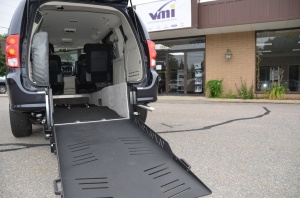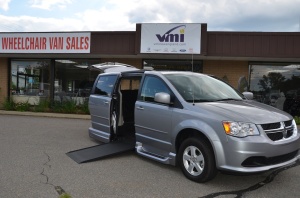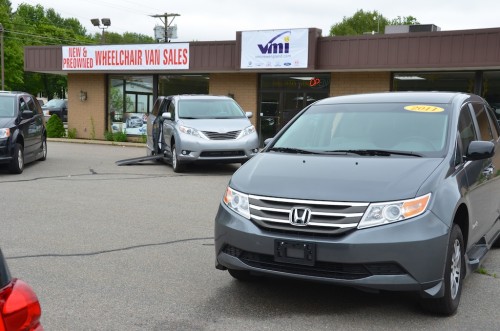Dodge Grand Caravan with VMI Northstar Conversion
VMI first developed the Northstar handicap van conversion in the early 1990’s to meet customer preferences for increased interior space. To this day, the VMI Northstar on the Dodge Grand Caravan minivan remains one of the best mobility ramp vans in America.
By sliding out of a space below the floor, the Northstar mobility ramp maximizes space inside the accessible vehicle. There are so many benefits of an in-floor wheelchair ramp, it is easily understood why its so popular.
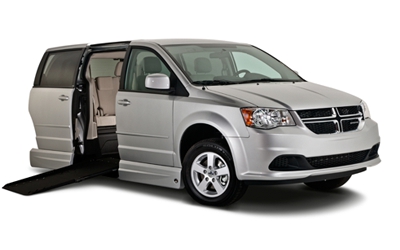
VMI New England Dodge Northstar Wheelchair Van VMiNewEngland.com
Description
•Interior handles, and switches, buttons are easily accessed
•Front passenger seat retains regular functions
•No additional noise from handicap ramp
•In the event of an accident, the accessible ramp is under the floor-not inside the mobility van
•Works on curbs up to 10 inches tall
•Increased maneuverability due to greater space inside the accessible van
•Ramp-free doorway allows easy entry/exit for ambulatory passengers
•Minimized conversion wear and tear (fewer ramp cycles to load/unload additional passengers)
•Uncluttered and clean wheelchair vehicle interior
•Mobility vehicle interior gets less dirt inside
•Increased handicapped ramp width
Specifications
•Maximum Floor Drop – 11″
•Handicap Vehicle Ground Clearance – 5.5″
•Door Opening Width – 30.75″
•Door Opening Height – 55.125″
•Usable Mobility Ramp Width – 29.25″
•Wheelchair Ramp Length – 45.75″
•Length from Back Seats to Kickplate – 58.25″
•Overall Floor Length – 86″
•Floor Width at Front Doors – 61″
•Interior Height at Driver & Passenger Positions (Without Sunroof) – 58″
•Interior Height at Center Position – 57.63″
•Steering Wheel Bottom to Floor – 29.5″
•Measured Down from Front Edge of Steering Wheel to Front Kick-Up – 16.25″
Standard Features
Dodge Grand Caravan with VMI Northstar only
•Extremely-low 8.0° handicapped ramp angle
•Sure Deploy backup system leaves accessible van conversion usable even with power failure
•Manual secondary backup system for additional peace of mind
•800lb. handicap ramp weight capacity
Dodge Grand Caravan with VMI Northstar AND Summit
•Fully-powered accessible van ramp
•11” drop FLEX Floor maximizes interior space and headroom for better maneuverability
•Complete undercoating and rust proofing
•PowerKneel system lowers the minivan to reduce ramp angle
•Seamless integration with Dodge Grand Caravan vehicle electronics
•Complete control through Dodge keyfob and interior switches
•Removable front passenger and driver seat bases
•No-skid wheelchair ramp surfacing
•Complete crash testing and compliance with all government safety standards
•3-year/36,000-mile warranty
Optional Features
•Durafloor (rubberized flooring) to match Dodge Grand Caravan interiors
••••••••••••••••••••••••••••••••••••••••••
Dodge Grand Caravan with VMI Summit Conversion
The Summit folding wheelchair ramp van conversion on a Dodge Grand Caravan is an economical choice compared to the popular Northstar in-floor handicapped ramp conversion from VMI. Summit mobility ramps utilize siderails that are 2 inches tall. This is especially important for those with a hard time navigating an incline. VMI Summit handicapped accessible van on the Dodge Grand Caravan also includes an industry best access ramp length of only 50.25”.
The short handicap ramp provides two key advantages to VMI customers. First, passengers can easily use the Dodge handle for the sliding door and switches because the handicapped ramp is not covering them. Second, users in wheelchairs have more room to move on and off the ramp when other vehicles park too close.
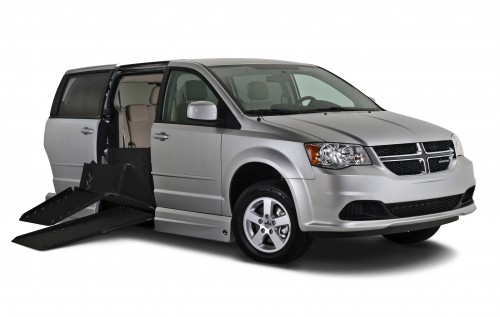
VMI New England Dodge Summit Wheelchair Van VMiNewEngland.com
Description
Dodge Grand Caravan with VMI Summit Only
•2” siderails help people with a disabilities stay on the ramp when coming in and out
•When other vehicles park too close, 50.25” ramp leaves users more room to maneuver
•By simply pushing outward on the ramp, it can be deployed incase of a mechanical/power failure
•Handicap ramp surface allows debris to fall through so it doesn’t end up inside the vehicle
•Mobility ramp has a quiet cabin dut to an anti-rattle device
•600lb. handicapped ramp rating
Dodge Grand Caravan with VMI Northstar AND Summit
•Fully-powered accessible ramp
•11” drop FLEX Floor maximizes head clearance and interior space for maneuvering a wheelchair
•Complete undercoating and rust proofing
•PowerKneel system lowers the minivan to reduce wheelchair ramp angle
•Total integration with Dodge systems prevents damage to vehicle/ conversion
•Accessible van conversion is controlled through interior sliding-door switches and Dodge keychain
•Easy-out passenger and front driver seat stands
•No-slip handicapped ramp
•Total crash-testing and compliance with all government standards for safety
•3-year/36,000-mile warranty
Specifications
•Maximum Floor Drop – 11″
•Mobility Vehicle Ground Clearance – 5.5″
•Door Opening Height – 54.25″
•Usable Wheelchair Ramp Width – 28.88″
•Handicap Ramp Length – 50.25″
•Length from Back of Seats to Kickplate – 58.25″
•Overall Floor Length – 86″
•Floor Width at Doors – 61″
•Interior Height at Center Position – 58″
•Interior Height at Drivers & Passengers Position (Without Sunroof) – 58″
•Steering Wheel Bottom to Floor – 29.5″
•Measured Down from Front Edge of Steering Wheel to Front Kick-Up – 16.25
Standard Features
•Power Folding Wheelchair Ramp with Non-Skid Surface
•Power Sliding Door with Easy Manual Operation
•Maximum Interior Headroom
•Undercoating and Complete Rust Proofing
•Manual Backup Ramp Operation
•Warranty – Mobiltiy Conversion Van
•Fully Crash Tested
•Remote Control Activation
•600 Pound Load Rating for Handicap Ramp
•9.7 Degree Handicap Ramp Angle
Optional Features
•Rubberized Flooring

